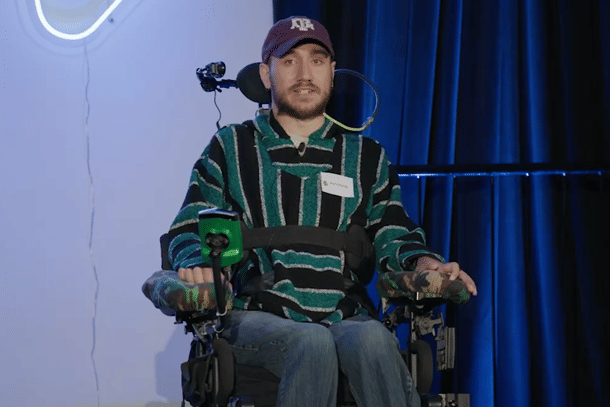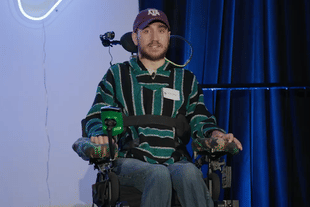Technology
Noland Arbaugh Got A Neuralink Chip Implanted In His Brain Over 100 Days Ago; Here’s How It’s Going For Him
Karan Kamble
May 14, 2024, 03:24 PM | Updated 03:46 PM IST
Save & read from anywhere!
Bookmark stories for easy access on any device or the Swarajya app.


It has been over 100 days since Noland Arbaugh — who has been living with quadriplegia for eight years, after a diving accident caused a severe spinal cord injury — got Neuralink’s chip implanted in his brain.
That’s a good enough time for an update on how the fully implantable, wireless brain-computer interface (BCI) is working, and Elon Musk’s company has obliged.
While most of the blog post is directed at how Arbaugh has benefited from the use of the device, a small part of it highlights the occurrence of a malfunction weeks after the surgery and how it was fixed by Neuralink to surpass even the initial performance.
Patient One
Arbaugh received his Neuralink “N1 implant” at Barrow Neurological Institute on 29 January. It was the company’s first-ever implantation of their BCI in a human.
The purpose of getting the implant was the restoration of digital autonomy for Arbaugh, and more broadly for anyone living with quadriplegia due to spinal cord injury (SCI) or amyotrophic lateral sclerosis (ALS) in the future.
But before the technology can be extended to more eligible people, the technology needs to be thoroughly examined. That is the purpose of the PRIME study that’s going on currently with Arbaugh as the first and, as far as we know, only patient. The safety and functionality of the N1 implant, as well as the surgical robot used for implantation under the supervision of a neurosurgeon, are being tested as part of this medical device trial.
The day after he underwent the surgery, Arbaugh was home. In the weeks since, he played online computer games with friends, surfed the internet, did live streams, and used other applications on his MacBook, all by controlling a cursor with his mind. It helped him “reconnect with the world,” his friends and family.
He used the device for both research purposes — to help Neuralink evaluate the performance of the implant — and personal use. The research sessions last for up to eight hours per day on weekdays. Personal use and recreation fill up the weekends.
“Y'all are giving me too much, it's like a luxury overload, I haven't been able to do these things in 8 years and now I don't know where to even start allocating my attention,” Arbaugh said.
His experience with the BCI was vastly different from the primary digital interface he relied on earlier — a mouth-held tablet stylus. Use of the mouth stick meant that a caregiver had to be around Arbaugh always and he had to sit upright, with prolonged use causing discomfort, muscle fatigue, and pressure sores, while also preventing normal speech.
Initially he found the mouth stick to be better, but eventually he “saw that BCI was just as good if not better and it's still improving.”
With the Neuralink implant, he could even just be lying on his bed. “It lets me live on my own time, not needing to have someone adjust me, etc. throughout the day,” he said.
Glitch
Weeks after the surgery, “a number of threads retracted from the brain, resulting in a net decrease in the number of effective electrodes,” Neuralink said in its latest update.
These “threads” are highly flexible, ultra-thin film arrays on which the implant is microfabricated. Each of them is thinner than a human hair and capable of being placed independently in the brain. The threads pick up on neural activity. The N1 implant is designed to record neural activity through 1,024 electrodes distributed across 64 threads.
The retraction of some threads from Arbaugh’s brain led to a reduction in bits-per-second (BPS) — the standard measure for speed and accuracy of cursor control. Higher BPS values indicate better cursor control. Neuralink is determined to raise its cursor control performance to bring it closer to that of able-bodied individuals.
In response to the thread retraction and subsequent drop in BPS, Neuralink said they made three moves: modifying the recording algorithm to be more sensitive to neural population signals, improving the techniques to translate these signals into cursor movements, and enhancing the user interface.
These refinements led to “a rapid and sustained improvement in BPS,” even surpassing Arbaugh’s initial performance.
Neuralink set a new world record for human BCI cursor control by clocking 4.6 BPS during Arbaugh’s first-ever research session. Over time, they have stepped it up to 8.0 BPS. The company has its eyes set on beating the roughly 10 BPS score achieved by Neuralink engineers who physically use a mouse.
Looking ahead
Next up, Neuralink intends to go beyond cursor control to include text entry by thought alone.
In the future, the Musk initiative aims to cross over from improving digital access to enabling control of robotic arms, wheelchairs, and other technologies that may help increase independence for people living with quadriplegia.
“I think it should give a lot of people a lot of hope for what this thing can do for them, first and foremost their gaming experience, but then that'll translate into so much more and I think that's awesome,” Arbaugh said.
Karan Kamble writes on science and technology. He occasionally wears the hat of a video anchor for Swarajya's online video programmes.





